Our final destination of the day was the city of Inverness, our 7th and final city in Scotland…
Inverness:
Status: Highland Unitary Authority, City, Scotland
Date: 14/03/2016
Travel: Car
Eating & Sleeping: Travelodge (A96)
Attractions: Inverness Castle, River Ness, Inverness Cathedral, Town House, Falcon Square, Steeple Tower, Old Court House, Greig St Bridge, Ness Bridge, Free North Church, Old High Kirk, St Columba’s, Eastgate Shopping Centre, Eastgate Street, Victorian Market, Old Caledonian Bank etc

We parked up in the Multi-Storey Car Park in the Eastgate Shopping Centre, which opened in 1983, and was later extended in 2003. It is an important shopping destination for the Highlands, as is Inverness as a whole, serving the largest catchment area in Europe. The Highlands is a vast area, and there are only two sizeable settlements, Inverness and Fort William.
Out in Falcon Square in front of the Centre stands the Mercat Cross (Scots for Market Cross). The cities original cross was erected in 1685, whilst the one we saw before us was a brand new design by Gerald Laing in 2003. The National Animal of Scotland, the Unicorn, adorns the top of the 37 ft cross, along with four falcons encircling it. The Falcons are in memory of John Falconer who opened the Falcon Foundry in 1858, although most of it has long since been demolished.

A few blocks East along Academy Street from the Square is Inverness Railway Station, which opened in 1855, originally the Terminus of the Inverness & Nairn Railway, roughly 17 miles long.
It eventually joined first the Highland Railway, and then the LMS (London, Midland and Scottish Railway) which ran most mainline services across the UK, after four large train companies merged.
Today the station runs services East to Aberdeen, South towards Glasgow, and North up to Thurso, for ferries to Orkney. A number of services also run up the ECML (East Coast Main Line) direct from London via Edinburgh up to the city.
Outside the station sits a Memorial to the Cameron Highlanders. 141 soldiers were killed whilst fighting in Egypt and Sudan during the 1880’s, so a permanent Memorial was erected in 1893.

We cut through to the River Ness from the Railway Station, and made our way to the steep slope atop which you will find Inverness Castle.
This beautiful looking building was the work of William Burn (1789 – 1870, Scottish Architect from Edinburgh) in 1836. It is the more modern incarnation of Inverness’s defenses, as there have been various Castles here since the 11th Century.
The most notable is a large, towered Castle from 1548, whose occupants famously denied entry to Mary Queen of Scots in 1562, causing the towns folk to take the Castle by force for her.
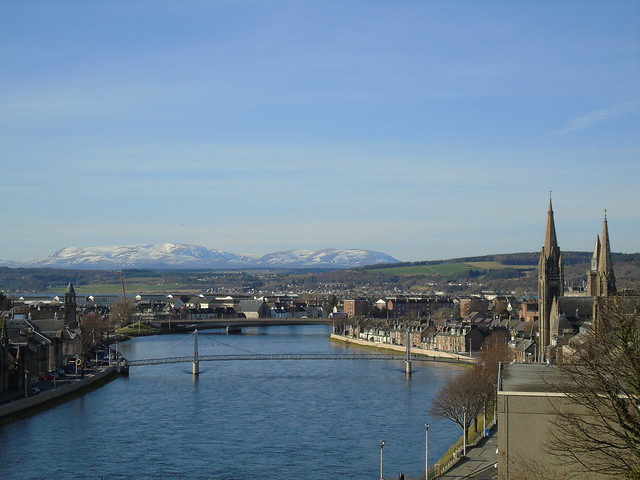
Not only does the Castle have a commanding presence along the River, it also offers the best view in the City.
In the distance, the prominent peaks of Ben Wyvis and Little Wyvis steal the skyline. They lie on the Northern side of the Beauly Firth, where the River Ness below us is gently heading.
The Ness is but 12 miles long, and connects Loch Ness with the Firth. The final stretch of the Caledonian Canal runs parallel for much of the route, again heading for Beauly.
Inverness has a number of well known Churches, whose spires are dotted around the skyline.
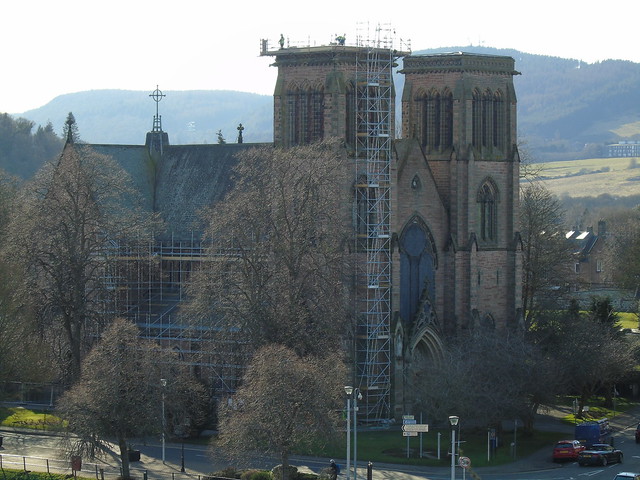
There is one religious building in particular though that stands out when your stood looking out from the Castle.
It is of course the Cathedral of St Andrew, on the far side of the River. It belongs to the Scottish Episcopal Church, and was founded in the 1860’s. A large Diocese covering the former counties of Moray, Ross and Caithness had just been created, and as the largest settlement in the area, Inverness was chosen to host the new Cathedral.
The twin towers at the Northern end of the building were originally intended to hold large spires, but sadly a lack of funds meant they were removed from the design.
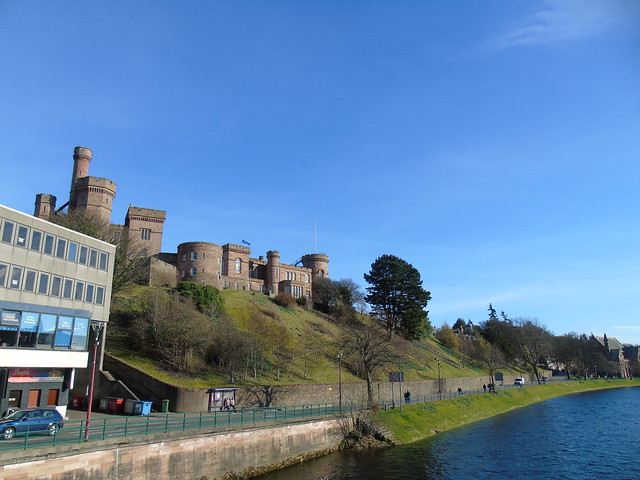
Leaving the Castle Mound in all it’s glory, we took a walk down the River, to take in some city views.
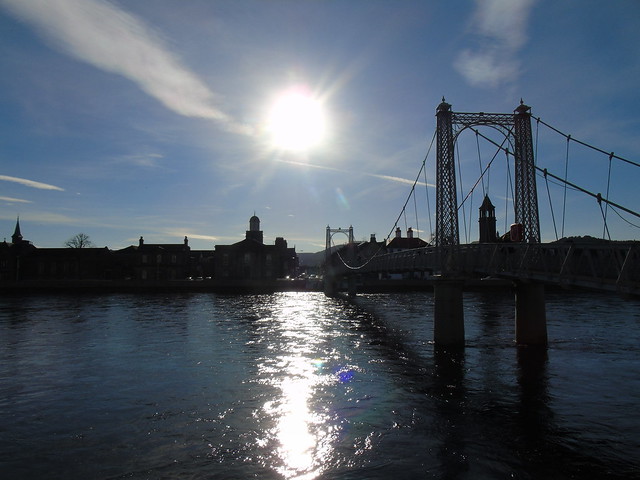
A number of bridges cross the River Ness in the city centre, and we stopped at the “Greig St Bridge”, a Steel Suspension Bridge from 1881, although it looks far newer!
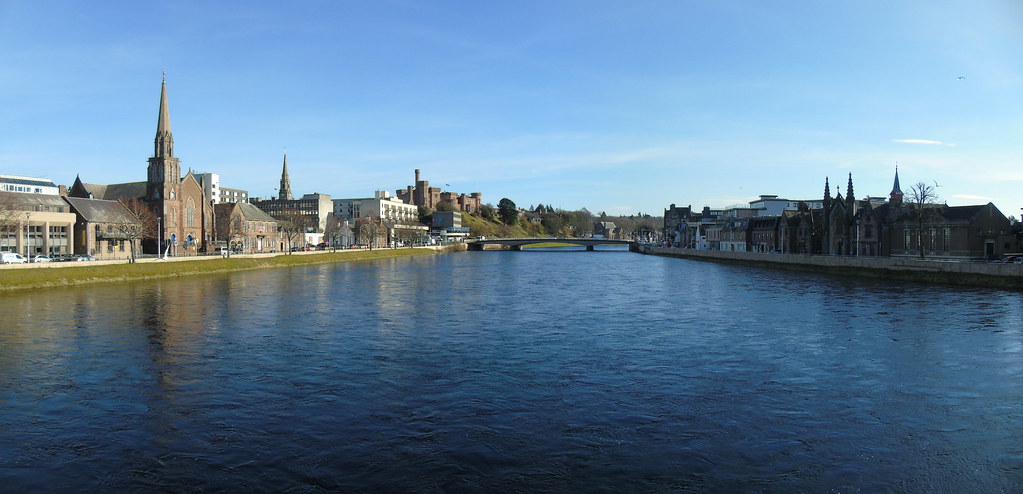
You get a fantastic view from here, with the Castle in the distance, and many of the cities Churches lining the riverside.
On the left is St Columba’s, built by Mackenzie & Matthews in 1852.
In the distance, crossing the river further upstream is the Concrete Ness Bridge from 1959, the latest in a long line of structures to cross the River in that spot. Until 1685 a Wooden Bridge was used, before making way for a new Stone one, destroyed in a Flood in 1849.

Here on the bridge, we were also level with another two Churches, starting with the “Free North Church” on the right.
Another Victorian Era addition, it was created by Ross & Macbeth in 1892, for the Presbyterian community. This particular branch of Presbyterianism has over 100 congregations in Scotland alone, as it has aligned with the Church of Scotland.
To the left is the “Old High Kirk”, the oldest Church we have come across so far. The main tower dates back to an earlier Church from the 16th Century, whilst the rest of the building was rebuilt between 1769 – 1772. The Tower features an unusual octagonal spire, which also predates rebuilding.
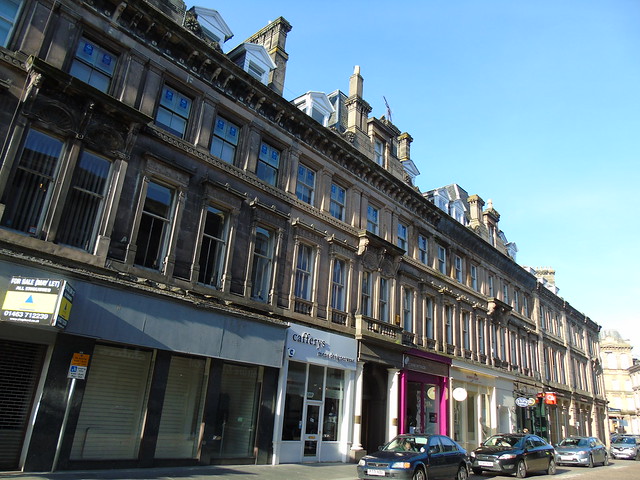
Moving back to the City Centre, we stopped outside one of the cities hidden Gems.
Taking up a whole block, is the stunning Victorian Market, built to replace the outdoor Market Place in the late 1870’s. The original building was destroyed by a fire not long after, so the present Market is from 1891.
Inside are hundreds of shops, in a maze of canopied districts. If you head round to Academy Street, almost directly opposite the entrance to the train station, you will find the original sandstone entrance to the pre-fire building.
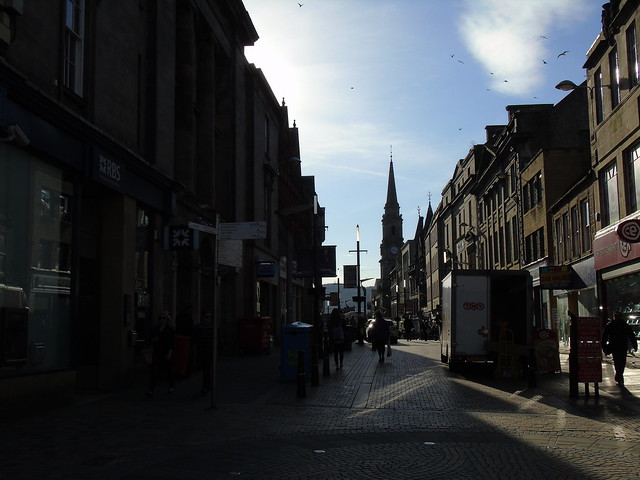
From here we cut through to “Eastgate”, the main thoroughfare in the city. It contains many of Inverness’s local landmarks, including the Inverness Steeple Tower, visible further down the street.
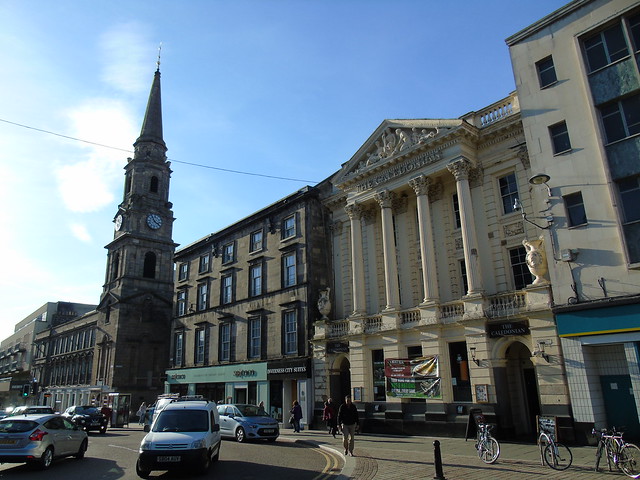
The Steeple is Georgian, completed in 1791. The spire contains three large bells, 150 ft above the streets below. To the left of the Steeple is the adjoining “Old Court House”, from 1794.
Two buildings over to the right from the Steeple is a large building with Corinthian Columns above the entrance. This was purpose built in 1847, again by Mackenzie & Mathews, as the new Head Office of the Caledonian Bank, founded in Inverness in 1838. It would eventually merge with the Bank of Scotland in 1907 after near bankruptcy.
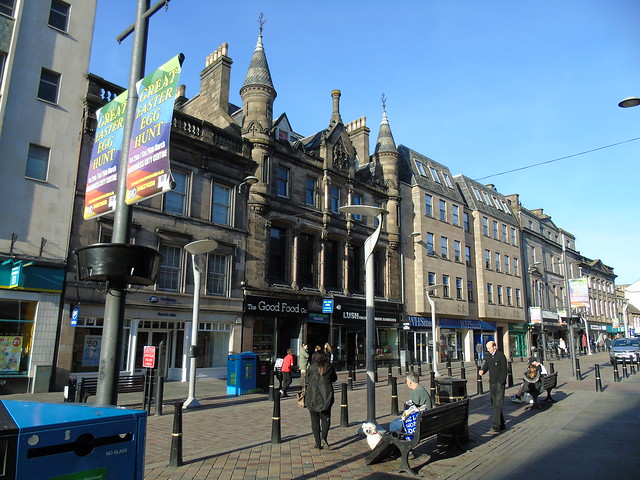
Eastgate is full of ornate buildings, with another good example being “Numbers 21 – 23a High Street”, the large building with turrets at either end of the roof.
Designed by Matthews & Lawrie, it was topped out in 1879 and is currently split up into a number of tenants, although the majority is currently used by the Highland Hostel.

On the far side of the street is one of the buildings I was most looking forwards to seeing… only to find it obscured by scaffolding!
Inverness Town House is one of the cities most stunning constructions, another lasting Victorian legacy, from 1882. It would first house the Town Council for what was then the Royal Burgh of Inverness, and now local offices for Highland Council.
The Town House, and Inverness itself also has a peculiar distinction with regards to government functions. The British Cabinet regularly meets at 10 Downing Street in London, however this changed for one day in 1921. Many of the Cabinet Ministers happened to be in Northern Scotland, when the Prime Minister, David Lloyd George had to call an emergency meeting in response to the worsening situation in Ireland. It was held at the Town House, the first time it had ever been held outside of London. The meeting resulted in the Anglo-Irish Treaty, allowing Southern Ireland to secede from the UK, whilst allowing the North to remain if requested.
Inverness is a magnificent city, and I am sure we only saw but of a fraction of the historic buildings on offer here. Against the stunning backdrop of the Highlands, it is a special place indeed.
It benefits from good transport links, as I said earlier, such as rail links to Thurso, Aberdeen and Glasgow. The A9, the main North/South route from the Central Belt to the Highlands bypasses the city to the North, whilst you can also take the A82 West to Fort William/Loch Ness, or the A96 East to Elgin and Aberdeen.
Inverness is also a good base for day trips out into the Highlands, and the cities Airport provides links to Shetland and Orkney.
The next morning, we left our hotel on the outskirts of Inverness, and headed North West along the A835 towards Ullapool, for our ferry to Stornoway…
